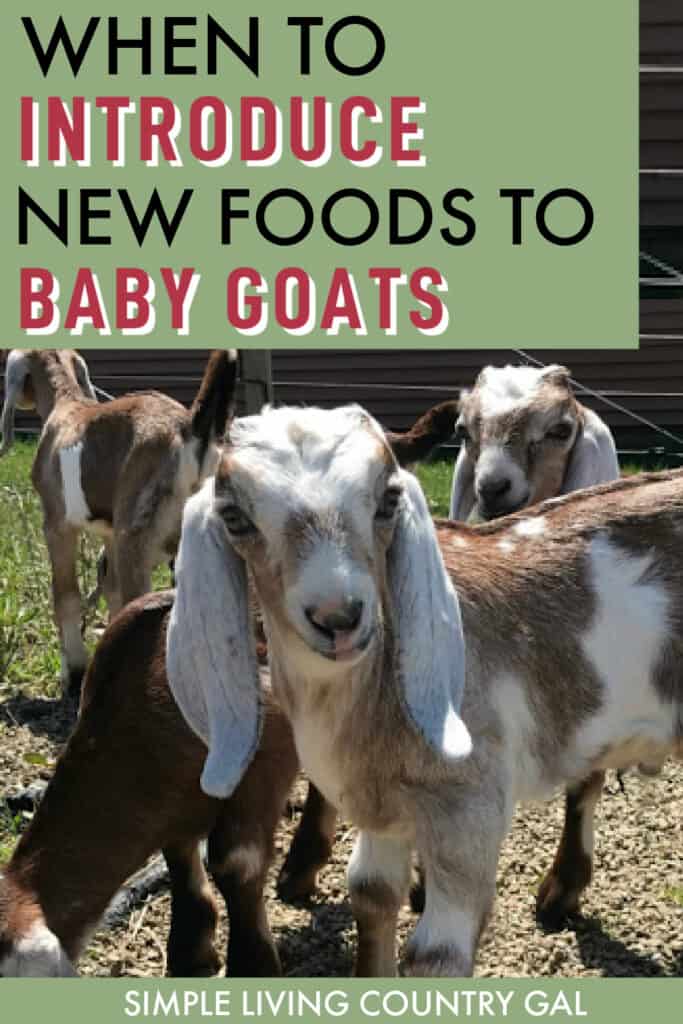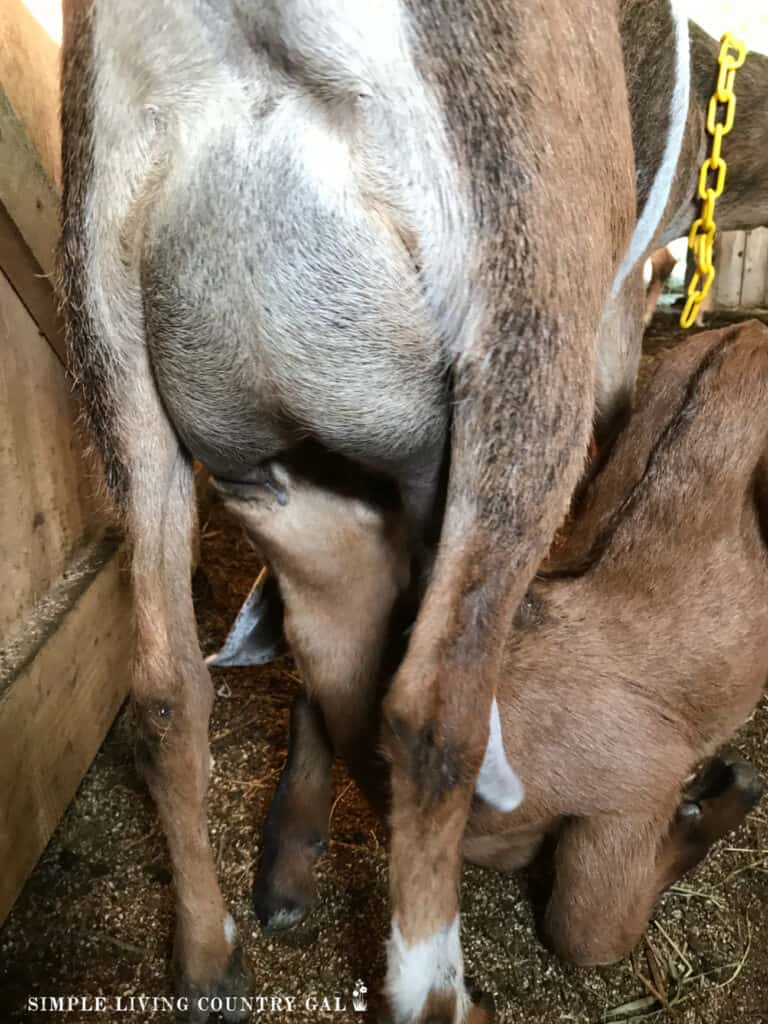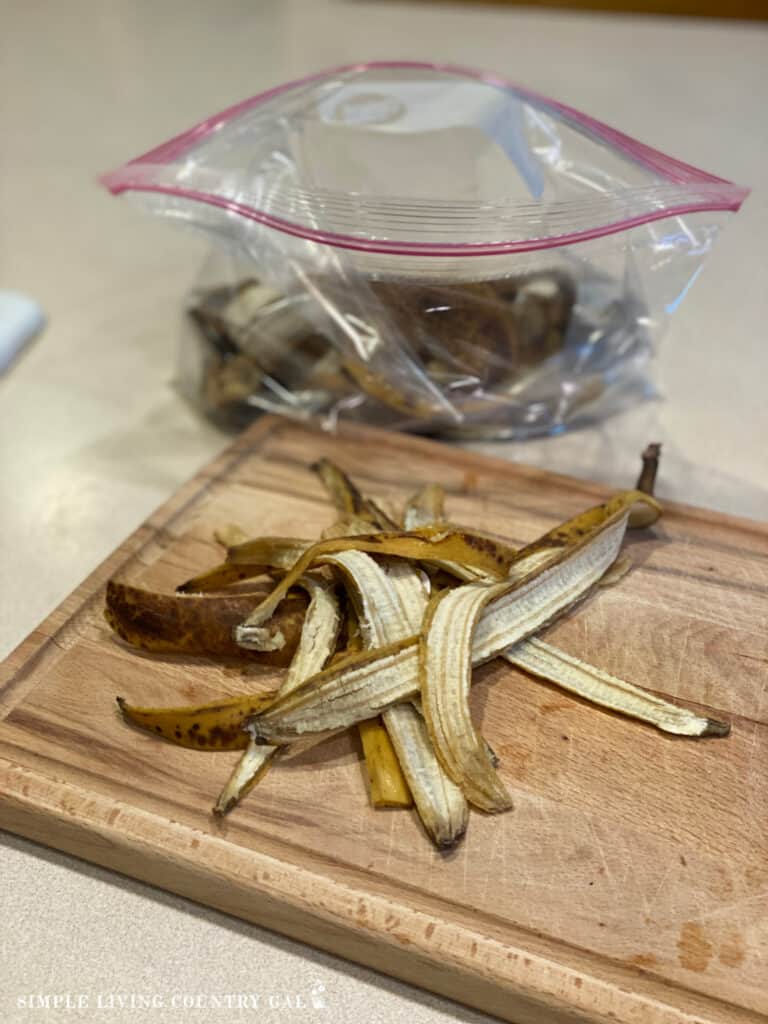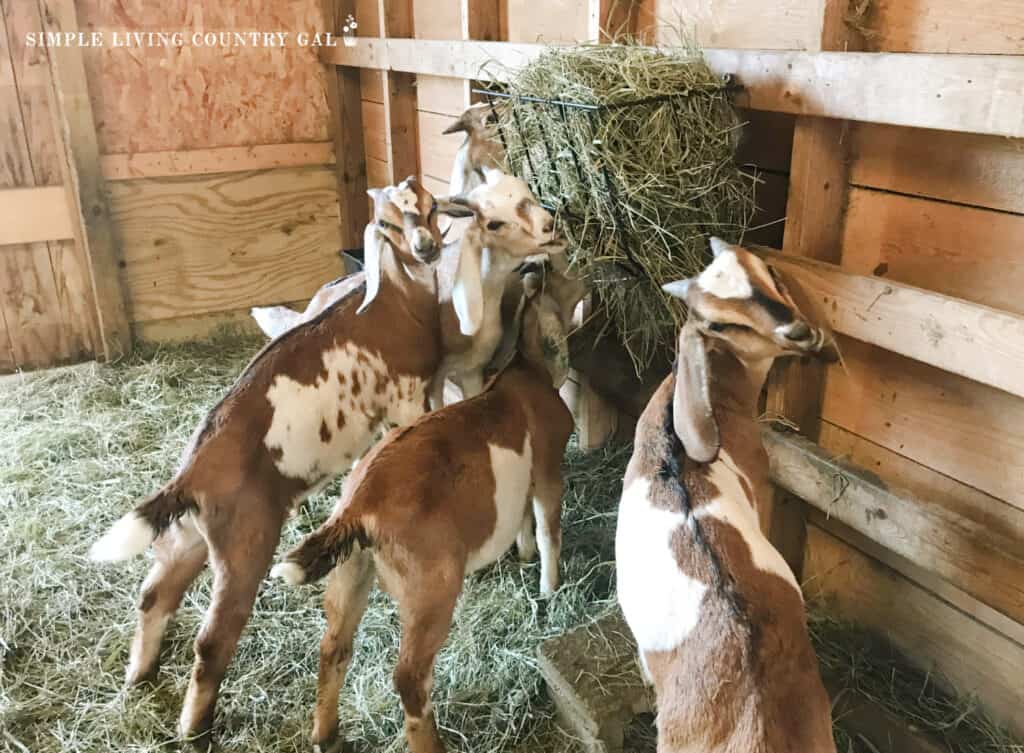Baby Goat Feeding Schedule
How to Establish a baby goats feeding schedule for your new goat kids so they can adjust in a healthier way. Get tips on when to begin adding in new things from hay to milk to grain as well as treats and minerals.
When learning about goat breeding and goat kidding, timing plays an important part especially with kids. Give young goats the time they need to acclimate to changes and you will have healthier and happier goats.

Welcoming baby goats is an adventure that is both fun and scary. Just a few minutes after being born, kids will begin walking and nursing, even exploring. This means your role as care giver and homesteader will begin early on. From ensuring they get colostrum from the mother to watching their activity so you know they are walking and moving well, being aware is a great way to help your herd thrive.
Another area you will want to be aware of is your goats food and nutrition. Goats eat many foods and when you have baby goats, you will want to be mindful of when and how to introduce each food so they can adapt in a more positive way. We will talk about the common things goats eat and when you can introduce each so your kids adjust well.
Understanding a Goat’s Digestive System
Before we jump into the feeding schedule, it’s important to understand how a goat’s digestive system works. Goats have four stomachs, just like cows, which enable them to digest tough plant material like grass and hay. However, at birth, their stomachs are not fully developed, and it takes time for them to adjust to different types of feed.
Each compartment serves a different function.
- The rumen, the largest compartment, is responsible for fermenting food, and it becomes the primary digestive organ as the goat grows.
- The reticulum takes smaller particles and moves them on to the omasum where water is removed and then sent to the abomasum.
- The reticulum is also where cuds are formed that you often see goats chewing on.
- The abomasum is the true stomach and acts much like our stomachs do, digesting food down. also play crucial roles.
Having a basic idea of how digestion works will help you better set up a feeding plan fo your herd.
Storey’s Guide to Raising Dairy Goats, 4th Edition: Breeds, Care, Dairying, Marketing

Feeding Timeline for Baby Goats
The first few weeks of a baby goat’s life are critical for their growth and health. The following feeding schedule takes into account the gradual introduction of solid foods and the best timing for weaning.
Birth to 1 Week: Colostrum and Milk Only
From the moment a baby goat is born, you will see it instinctively look for it’s mothers udder looking for their first meal which is colostrum. Colostrum is a nutrient-rich substance, often referred to as ‘first milk,’ is crucial for jump-starting the kid’s immune system. Colostrum should be consumed within the first 30 minutes to an hour after birth to maximize its benefits.
Watching for that first suckle from a kid on the udder will help you relax knowing they got the important colostrum in their systems.

For the first week, kids should consume only colostrum and milk, primarily from their dam, aka mother. In cases where bottle-feeding is required, high-quality colostrum replacers is a must have to get your goat kids protected with the crucial antibodies needed for their immune systems.
1-2 Weeks: Introduction to Hay and Minerals
Around one week old, goat kids can begin nibbling on high-quality, clean hay. Alfalfa hay is an excellent choice due to its high nutritional value and digestibility for young goats but it is not readily available in all areas. Look for local grown hay that is dry and mold free such as Timothy hay or Orchard grass.
More on Feeding Hay:
Alongside hay, free choice minerals should be available for your goats. You can use a mineral block or mixed the minerals they need in with their feed. Minerals are essential for bone development, the formation of milk in does, and many other bodily functions. They also help supplement in areas where your location may be deficient.
Purina | Goat Mineral Supplement Block for All Types and Lifestages | 33 Pound (33 lb.) Block


2-4 Weeks: Gradual Introduction of Grain and Treats
Between two to four weeks, start introducing a small amount of grain to the kids’ diet. A mix specifically designed for growing goats is ideal, as it will contain the necessary nutrients. While grains can be introduced, it is important to be mindful of protein levels, especially for wethers and bucks, as excessive protein can cause urinary calculi or ‘water belly.’
Goat treats, can also be given occasionally as a reward or to help with goat training, but they should not replace a balanced diet.
Goat Treats:
- Watermelon
- Bananas or banana peels
- Black Oil Sunflower Seeds
- Pumpkin
- Slices of apple
Goats love bananas, even the peels. As you eat a banana tear the peels into thing strips and keep them in a plastic bag. When you need a healthy treat for your goats, you will have a supply ready to go!

Weaning Period
Weaning is how you help your kids transition from milk to solid food exclusively.
Mother
Kids on their mother are typically weaned at 8 to 12 weeks of age, depending on their growth rate and overall health. This process can be gradual, with mothers becoming less accessible over time as you transition to full solid feeds.
Bottle
Goat kids can be weaned off the bottle between 8 to 10 weeks of age. Over time, the number of feedings is reduced, and the contents of the bottle is supplemented with more solid feed.
Weaning Process
The weaning process, whether from the mother or the bottle, should be gradual. Abrupt changes can stress the goats and potentially lead to health issues. Here are some tips to ease the transition:
- Slowly decrease the number of feedings, approximately over a two-week period.
- Offer freshly filled water sources within their reach to make hydration convenient.
- Observe your goats closely during the weaning process for signs of distress or malnourishment, such as excessive bleating or refusal to eat.
Here is our schedule for weaning dam raised kids:
- At 2-4 weeks of age we separate the kids from their moms at night. This allows us to milk full udders in the morning. The kids are allowed access throughout the day.
- At 6-8 weeks of age, we keep the kids back during the day giving the moms access to the pasture during that time. Kids are then able to nurse in the mornings before the herd goes out to pasture.
- At 8-12 weeks, kids are moved to their own pen and pasture for the final weaning.
READ: When and How to Wean Goat Kids
Feeding Considerations
Establishing a feeding schedule is not a one-size-fits-all approach. There are several things you will want to keep in mind. Things like the breed of goat, their overall health, and their weight gain.
- Take weights of newborn goat kids and keep a record for each. Every week, do another weight check to be sure everyone is gaining weight constantly.
- Have a separate area for kids only where you can monitor how they are eating as you introduce new foods.
- Create a feeding routine and stick to it. Goats are creatures of habit and appreciate the predictability of a routine.

Raising baby goats is all about timing and quality. Timing of feedings and the quality of hay and grain you offer. When it comes to adding in new foods, slow is your friend as it will help those fragile stomachs adapt to the new foods they are trying. By following this baby goat feeding schedule you’ll be on your way to raising healthy and happy goats.







